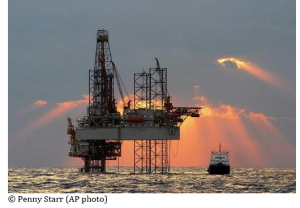Practical Management of Cumulative Anthropogenic Impacts with Working Marine Examples
By Robbie Roemer, RJD student
Paper by Andrew Wright and Line Khyn
Technological advances as well as the need for energy exploration and natural resource utilization have intensified and expanded anthropogenic pressures on the environment. Nowhere are these pressures more prevalent than the marine coastal areas of the globe; fisheries, offshore renewable energy sources, and the ever-increasing demand for petroleum are the highest contributing factors. This increase in activity subsequently surges the magnitude, extent, and time-interval of adverse effects to the marine biotic ecosystem.
Recently there has been a major shift in the strategy of ecosystem management, including ecosystem based management approaches and marine spatial planning. In order to meet the requirements of these new management approaches, efforts have been implemented to quantify the cumulative impacts of human activity on marine species populations. The authors believe there is sufficient scientific evidence to support limiting the impact to marine organisms, and suggest a six-pronged approach for facilitating the capping of anthropogenic effects to the environment.
Human (or anthropogenic) activity originates in many varieties, including commercial shipping, oil and gas exploration, dredging, hunting, industrial construction, and even fishing. With such a wide variety of activities taking place it is to be expected they introduce numerous threats and stressors to the marine ecosystem including physical disturbances, chemical runoff, and noise pollution. The authors stress the importance of not adding the total impact of all interactions, citing the importance to quantify interactions that could potentially lead to greater overall impacts to the ecosystem. The authors state that ecosystem based management and marine spatial planning may offer solutions to this paradigm, but these potential solutions are data hungry, and move at an incredibly slow pace. While anthropogenic impacts affect all forms of marine life, the study centered on marine mammals due to particular expertise of the authors.
The Six-Pronged Approach
- Minimizing Exposure
Exposure of wildlife to human activities at lower measures will undoubtedly have less of an impact than species exposed to higher rates and levels of anthropogenic activity. It is suggested early evaluations as well as Environmental Impact Assessments (EIA) will minimize exposure of a certain species or at the very least, reduce the exposure to sensitive individuals if total avoidance cannot be achieved
- Management Cycle
Assessing the collective impacts of a project with enough advance of each activities start dates is deemed to be one of the simplest ways for managers to effectively limit the collective impact of the projects. Management cycles can be established so that proposals for human activity within a management area must be submitted by a given deadline so all conjunct activities or projects can be considered simultaneously. The U.S. National Fisheries Service has already utilized application cycles, establishing application deadlines for all researchers planning to focus on Stellar Sea Lions.
- Cross-Company Collaboration
In relation to management cycles, the combined effects of multiple anthropogenic projects cannot be evaluated on a linear scale. Instead it is suggested quantitative models be used, accounting for different aspects of the entire proposed list of projects. This will subsequently allow companies to reduce cumulative effects before they submit applications.
- Zero-Sum Management
Naturally, anthropogenic environmental damage could be curtailed if the current level of impact from human sources was considered the maximum allowable. Zero-sum management effectively represents no additional impact can be added to a population or region, and the impacts from ongoing activities must be offset. This management strategy may be particularly effective for species populations that are severely declining or even data deficient.
- Uncertainty Built into Thresholds
A caveat to zero-sum management is the need to recognize and accept that the quantified magnitude of any impact is most likely underestimated, regardless of how the magnitude is measured. The recognition of this uncertainty as well as others in management strategies is useful, if not essential, for mitigating anthropogenic effects to marine populations. The need for integrating such uncertainties in management has already been realized and incorporated in the calculation of maximum marine mammal bycatch take for fisheries, which is known as potential biological removal (PBR).
- Facilitating Future Management
The authors suggest that management agencies should require the collection of data to determine the extent to which the marine habitat would be altered. To ascertain anthropogenic stressors, a call for basic biological research be assessed prior to the activity. The authors also propose the publishing of said data to allow public dissemination of the results.
Such management strategies as the ones listed would undoubtedly have significant cumulative effects to reduce anthropogenic effects to marine organisms. Assessing and applying management strategies like these is most important considering the intensification of offshore energy exploration, especially as the potential for energy exploration escalates as the artic opens from climate change.
There are several disadvantages that should be mentioned in implementing such management strategies. Management cycles have been proven to be detrimental to those who propose the anthropogenic activities (industries), which will lessen support for management agencies. Several presumptions also underlie the effectiveness of area based mitigation, such as, different habitats of the overall ecosystem must be viewed as equally important to the species of interest, and species perceive the anthropogenic disturbances as an immediate threat, responding accordingly by utilizing avoidance.
If these shortcomings can be addressed and moderated, the six management approaches listed could have long standing positive effects to mitigate the detrimental anthropogenic effects to the marine ecosystem, used independently or synchronously.
Citation:
Wright, Andrew J., and Line A. Kyhn. “Practical management of cumulative anthropogenic impacts with working marine examples.” Conservation Biology(2014).





Leave a Reply
Want to join the discussion?Feel free to contribute!